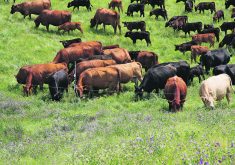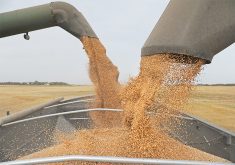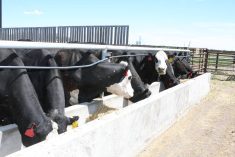Former friends?
With friends like that who needs enemies? The front-page article in the Nov. 8 edition of the Western Producer made me think of that quote.
Freight rates have gone from just over $6 per tonne to almost $40 per tonne in less than 15 years. Handling and elevation has increased from about $8 per tonne to nearly $18 per tonne in 20 years. Most of this time grain prices have been stable at low levels.
CN Rail set up a car allocation program which seriously affects producer car loading, which in the final analysis can put $2,000 per car in the farmer’s pocket.
Read Also

Agriculture productivity can be increased with little or no cost
There’s a way to enhance agricultural productivity with little or no cost. It doesn’t even require a bunch of legislative changes.
It also affects independent farmer owned elevators, local processors and short line railroads. Remember, to help their bottom line, these are four routes farmers can use to move their grain.
How bad is it on the farm? How desperate are farmers to try to survive?
Stats Canada is projecting realized net farm income for 2007 at $1.5 billion, of which $3.7 billion is taxpayer-funded farm support payments. When you do the arithmetic, it looks like 2007 net income from the markets is $2.2 billion short of expenses.
I am not surprised James Richardson International and Cargill sided with CN Rail, but Viterra? It used to be Saskatchewan Wheat Pool, a co-operative, our friend. So, with a friend like that, who needs enemies?
– Lorne Jackson,
Riverhurst, Sask.
Fine print
Re: Syngenta ads and Lorrie Plewis letter, (Open Forum, Nov. 1.)
When these ads appeared, the first thing I noticed was the word “Advertisement” in very small print. We are always told to read the fine print.
My husband didn’t see the A-word and was telling me about all these wonderful happenings. I said look closely and in the end you will find out it’s some chemical company. Who else has the money to pay for these? Certainly not the farmers.
It’s plain to see just thumbing through any farm newspaper who makes the profits – the chemical and machinery companies. All off the backs of farmers trying to break even, never mind a profit.
– Elaine Sloan,
Morinville, Alta.
No meat
Re: Meat advocates discredit study, WP, Nov. 8.
No doubt Ron Glaser of the Beef Information Centre is going to do his very best to advocate eating meat. His paycheque depends on it.
The recent study from the World Cancer Research Fund and the American Institute for Cancer Research only reinforce the same message that I have been hearing for years. Eating large amounts of animal products contributes to obesity, diabetes, heart disease, cancer and a whole other list of problems.
If we keep eating these same products, we are going to keep getting the same results. I for one have felt a whole lot better since I ditched the meat and the dairy.
– Lesley Fox,
Vancouver, B.C.
Organic worries
A letter to the editor in a recent WP issue brought up concerns by an organic farmer that the pioneers of organic farming are being left behind.
In the same issue, Laura Telford of the Canadian Organic Growers association wants a loophole to be closed that may allow small organic farmers selling into local markets to not share the same amount of certification cost and inspection burden as bigger growers. One rule fits all.
If this comes to pass, the only small organic farmers that will be able to thrive will be boutique product marketers selling costly product to a small, rich group of Canadians.
As a person who started out in the organic business in the 1980s, I am concerned that the original values and goals are vanishing under reams of bureaucracy. The original goal of a national organic program was market access, particularly for the large grain sector to hold onto the export markets.
Like often happens with movements that become successful, bureaucracies become stakeholders themselves and become far removed from the concerns of the original constituents. …
The colossal organic bureaucracy of NGOs and government committees being created is not without its casualties on the farm.
This summer I have been trying to help my old mentor, an octogenarian organic farmer who is perhaps the oldest living pioneer of organics in North America. He has been organic for over 50 years. There was a time when his produce was sold in every State in the U.S.
Now in his semi retirement he farms 20 acres of produce, all destined for local markets. This year we were quoted as high as $2,400 per year certification cost for 20 acres. As a professional marketer who understands the organic marketplace, I can assure you that a shiny little Canada organic logo is not going to inspire such consumer confidence that such ridiculous costs can be absorbed in the profit margin. He may just be forced out by the monster he has created. …
The new organic rule is here to stay, I’m sure. Talk of tightening the rules before the ink is dry is akin to the grain buyer changing the spec after the grain truck has left the farm.
– Mike Larsson,
Etobicoke, Ont.
Prices unknown
Farmers intent on destroying the Canadian wheat Board should do a rethink. There is a big difference between the board’s powerless directors and the bureaucracy that dictates our prices.
For weeks ending Sept. 21 to Oct. 26, Vancouver world wheat averaged $10.43 while the CWB fixed price high was just $8.41, only on Oct. 1.
The vote should be monopoly or no monopoly and the next step to demand that, since this is our money anyway, operation of the CWB be relinquished to farmers.
We could be selling bulk commodities directly or delivering on the futures and receiving freight subsidies instead of paying high basis to grain companies.
We would lock in higher grain prices, sell the Canadian dollar, pay farmers to stockpile grain, go on the stock market or whatever it takes to sustain our income. A few thousand dollars is not a big investment when we consider the alternatives, because there really aren’t any.
The CWB is made to order with competent directors and experienced staff. Not surprisingly, many U.S. farmers may want to join in.
The next thing we can expect is another long price spiral where fund investments sell grain futures and squeeze prices down. Our last good year was 1995-96 when world wheat averaged $9.23, but dropped to $6.32 by 2001-02. When prices get too low we should buy a few thousand contracts. Speculators could not feasibly make delivery on large amounts of grain. They don’t even have any and why would we sell to them? For each $1 price increase, we would realize $5,000 US futures profit on every contract.
Every year hundreds of families are forced off the land only because we are the world’s worst marketers. We don’t have a clue where prices are going, how high, how low, when or for how long?
We need to put a dent in this corrupt system and get back to a normal lifestyle again.
– Louis K. Berg,
Sedalia, Alta.
Spent on nothing
Re: Gerry Ritz comment, Opinion, Oct. 25.
He said in his letter that the government is spending hundreds of millions of dollars on this biofuel industry. He also said that the biofuel production and use produces fewer emissions than conventional fuels. Now let’s get the facts straight.
We burn a litre of fossil fuel to grow, process and transport a litre of ethanol so in other words, we burn one litre to get one litre. This is the way government works.
This reminds me of the metric confusion some years back when the federal government spent millions of dollars on nothing, the gun registry, the answer to all our problems, again hundreds of millions of dollars on nothing, and the biofuel industry, hundreds of millions on nothing.
Switching to biofuels would require a lot of extra land. In fact, substituting 10 percent of fossil fuel to biofuel for all vehicles would require 40 percent of the entire cropland and this is simply not sustainable.
We need to feed the people of the world. 2007-008 will mark the seventh year out of the past eight in which global grain production has fallen short of demand.
The demand for food is rising rapidly and population is rising, 2.5 billion will join the global population in the coming decades.
Every six years we are adding to the world the equivalent of a North America population. To divert food supplies into biofuels means that we are in an opening phase of an intensifying food shortage.
– Arnold Helgeson,
Southey, Sask.
Road folly
Alberta’s government recently announced it will cost $60 million to build the Canamex Highway 4 bypass around the Town of Milk River, or about $2 million to supply highway business to each town business.
What is interesting is all the investigations being contemplated over Mulroney’s dealings, while over the past eight years Alberta’s two premiers have created a totally insane highway situation costing Alberta taxpayers $40 million more than the original eastside proposal, without being accountable to anyone.
It takes millions to relocate four kilometres of CPR mainline, a controlled railway crossing, a new bridge and removal of the old rail bridge. Millions to reinforce a kilometre of unstable river bank and service it yearly. …
On the east side of Milk River lies wide open river bottom, hay and farm lands, no farm sites, acreages, infrastructure. It leaves all the present highways, country roads, underground and overhead infrastructure, railway, river embankment undisturbed.
It would connect directly to Milk River’s major east-west highways, with excellent low terrain underpass areas available….
For eight years our community, including the County of Warner council have tried to bring common sense, reason and justification to this costly, insane Klein – Stelmach decision. Results: stalled silence….
Please contact your MLA or premier (and) demand that present construction be halted, until a full independent investigation has been completed and compiled (and) made available to all Albertans for study…
– Wray Swanson,
Milk River, Alta.
No nukes
I have been reading several articles printed recently about nuclear energy developments in Alberta and would like to comment.
With all of the alternative types of energy that we have in Alberta one wonders why we would even consider a nuclear power plant to be built in the (Peace River) region. We have wind, biowastes, etc. that can be turned into green energy without creating a hazardous waste product that will haunt our future generations for many millennia.
We have been told it is safe. I am sure the residents of the Chalk River region in Ontario were told the same. On Dec. 12, 1952, a partial meltdown of the NRX reactor at Chalk River, Ont., occurred, the world’s and Canada’s first nuclear accident.
Your readers can read the information for themselves at this link http://www.cns-snc.ca/history/nrx.html.
Nuclear accidents can and have happened. When they occur, they impact a large region. Albertans and British Columbians alike should have a say in this matter.
– Neil Peacock,
Sexsmith, Alta.
Taser matter
After seeing on the news the horrible story of Robert Dziekanski, I called Vancouver’s CTV news to see what could be done for his mother. They gave me an address for a trust fund for her to help her.
I have enclosed it here, if you could please run it in your newspaper to give the Saskatchewan people a choice to give to her.
Zofia Trust Fund (Robert Dziekanski’s mother), Valley First Credit Union, 100 – 180 Seymour St., Kamloops, B.C. V2C 2E3, 250-374-4924. Cheques can be made out to: Zofia Trust Fund, account #74666 and mailed to the bank as our credit unions here are only Saskatchewan-based.
– Krista Kell,
Regina, Sask.














